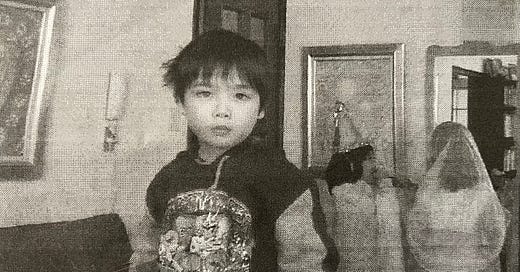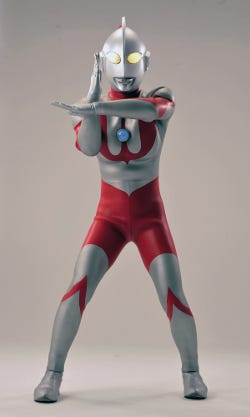God has a tremendous sense of humor. Then again, why shouldn’t he? If he could create mountains and oceans, sun and stars, and engineer synchronicity beyond our wildest dreams, then why be surprised that God knows a thing or two about irony, surprise and perfect timing. My son, Seiji, sure had a good laugh.
In 2008 I was invited to exhibit at an exhibition to promote AIDS awareness near my home, at Setagaya Museum. I didn’t even know awards were being handed out until I saw next to “Man with Rod and Bowl” a citation from Koji Ishizaka.
Seiji Wakabayashi at home in Tokyo, circa 2008, with big sister Miriam and friend Sota in the background.
Apparently, I had won the Ishizaka Prize. The name meant nothing to me, as I wasn’t much of a television watcher in my thirty years in Japan. In 2008, my son Seiji was six, and unlike me, was attuned to every single superhero that the marketing geniuses of Japan came up with to lure kids to want dolls, toys, costumes, masks, notebooks, posters and a lot more decorated with their favorite superheroes.
There was one superhero that I particularly despised. This was Ultraman, an expressionless grey-faced space alien with eyes that lit up from within his plastic hard shelled head.
Ultraman was the absolute antithesis of everything that mattered to me as an artist. I believed then, as I do now, in the power of the face, particularly kind eyes and a gentle smile, to spread happiness, to send love. Having young children, I thought this mattered. But my son had different ideas. The more eery, monster-fighting, the better.
Scroll ahead to 2024. The Ishizaka-award winning pastel drawing has accompanied me from Tokyo to Israel and it sits in a portfolio case relaxing—to put it nicely. Speaking to a friend the other day, surprisingly Ishizaka came up in conversation . So, after I put down the phone, I looked him up.
Koji Ishizaka was none other than the narrator for the first 19 episodes of the Ultraman series, debuting in 1966. If you’ve ever raised a son, and let him watch TV or videos, and happened to live in Japan or be an Japanese anime enthusiast, he knows exactly who is Ultraman. Even when is mother doesn’t.
Over the years, I’ve learned that every work of art we do, leaves a fantastic trail of potential serendipity. The trail can lead us to people, places, culture and events that circle back to our own life stories. I often do research after a painting is completed in order to understand more about why I may have chosen a particular element. Research is a way we can expand what we know about the elements we choose, and to even change our minds about how we look at a work of art. In truth, I still don’t like Ultraman’s appearance. He stands at odds with my belief that if you have a face, you jolly well show it.
But today, I’m grateful for Ultraman. My son Seiji is 22 now. He’s in Japan. I’m in Israel. When we speak, which is thankfully often, the subject of his childhood rarely comes up. And yet, those precious years were the foundation of his happiest memories—which like it or not, included a whole stage full of Made-in-Japan superheroes.
So, I sent Seiji a FB message with the news.
Keep reading with a 7-day free trial
Subscribe to Genesis Art Unpacked to keep reading this post and get 7 days of free access to the full post archives.





